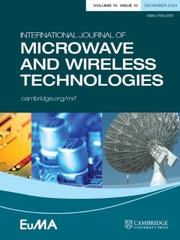No CrossRef data available.
Challenges in design and realization of large-sized and widely-separated Ku-Tx-Rx contoured-beam Gregorian reflector antenna
Published online by Cambridge University Press: 05 November 2025
Abstract
A ϕ2.5 m Gregorian antenna has been designed, analyzed, developed, and tested for a contoured beam for India and its Islands. The downlink band is 11.7–12.2 GHz. Uplink band is 17.3–17.8 GHz. The frequency band ratio is 1:1.52. The feed system consists of a radial corrugated horn and a turnstile orthomode transducer. Since there is a common feed system for Ku-Tx and Ku-Rx bands, it causes a large variation in the phase center for Tx and Rx bands. This large disparity in Tx and Rx phase center makes shaping challenging to achieve higher edge of coverage (EoC) gain, over widely separated transmit and receive bands. The optimization is carried out to achieve enhanced EoC gain and compliance of cross-polar isolation (XPI) through surface shaping of main and sub-reflectors. We have also optimized the feed coordinate to achieve the goal. The scattered near field at feed aperture is also minimized to get good XPI. Minimum radius of curvature of the surfaces has been controlled, which is required for the manufacturing of sub- and main-reflectors with minimum fabrication error. A new technique has been devised for the accommodation of a Gregorian antenna on a spacecraft with suitable radio frequency (RF) clearance. The impact of photogrammetry targets on RF performance is also brought out in the article.
Information
- Type
- Research Paper
- Information
- Copyright
- © The Author(s), 2025. Published by Cambridge University Press in association with The European Microwave Association.


